The Basics: Chicken Stock
Of all the many subsets and categories of cuisine, my favorite is sauces. Sauces are paired with almost any food these days, from the ketchup with your McDonalds fries, to the gravies with biscuits or Thanksgiving turkey, to the au jus with your French dip. They may be as simple as melted butter, or as refined as an a l'orange gastrique. The basis for many families of sauces (and their derivatives) is a broth or stock, which can be made from vegetables, meat, or fish. Today, there are a rainbow of options for this: bullion cubes, powdered broth, canned or bottled or boxed stocks, pastes and concentrates, and, of course, hand-made.
The great culinary grandfather of modern times, August Escoffier, refused all options except carefully made stock. He famously said that it is better to use plain water for a sauce than to use anything but a pure, refined, handmade stock. This philosophy has a lot of modern believers, Michael Ruhlman giving great examples of this in his books and blog.
I make a lot of stock, and a lot of varieties of stock, specifically because I love sauces. Beef and chicken stock are my staples, and I have also made veal, lobster, shrimp, crab, and lamb stocks if I have enough of the ingredients (though perhaps not to the same volumes). I have a small chest freezer in my garage solely devoted to keeping my stocks frozen and fresh, and for holding bones or shells until I have enough for another batch.
As much of a fanatic as I am about stocks and sauces, do I agree with Escoffier? Well, not exactly. If I have stock, I'll use it. If I have another stock (chicken instead of shrimp), sometimes I'll substitute. If the stock is going into something heavily flavored -- a rustic gumbo for example -- I'll certainly use a bullion cube in water if it's all I have, perhaps even before using the fat-clumped dishwater that comes in cans. If there are mirepoix vegetables around, I'll make a court-boullion rather than make a sauce out of plain, tasteless water.
I try to have stock on hand, though, so I won't get into a substitution situation. That's one of the great things about making your own stock, you can literally make quarts and quarts of it at a time, and it will save very well in the freezer for a long, long time -- months if not a year or more.
Nor is stock only for sauce making. Instead of plain water, I make white rice with 3 parts stock and 1 part wine, making sort of a faux risotto. Stocks can be the basis for soups, or for poaching meat or fish, and will flavor braises.
I like to save my stock in individual 9oz plastic containers, which allows for a cup of stock plus room for freezing expansion. With chicken stock, I also save a few half-cups in 5oz containers, for those times I need less than a cup. I use a Sharpie marker on the outside so I know what kind of stock it is (Ch for chicken, B for beef, etc) since frozen, dark freezers with frost-covered containers can be tricky to figure out.
Since the stuff lasts a long time, I make as much as I can at once -- this recipe yielded 18 cups total.

I start with some chicken carcasses. Whenever we make roasted chicken, I save them in the freezer, then on stock day, I thaw and clean them. This particular day, I had one chicken carcass and four cornish game hen carcasses. I also bought some turkey necks on sale at the store for a bit of extra body and flavor. I've also used chicken gizzards, but stay away from chicken livers, which can give an off taste and sometimes will fall apart and cloud the stock.
I pull everything off the bones, then sort through the meat to make sure as little skin and fat remains. Leave the cartilage, as some of it breaks down into a natural gelatin, which gives a nice body to soups or sauces. The bones, any remaining meat, and the turkey necks (cleaned of skin and fat) go into a 10-quart stock pot, then everything is covered by water by three or four inches.
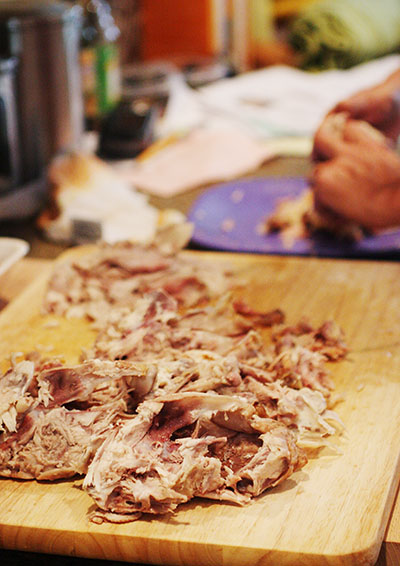



Blanching the meat and bones with a rapid boil is a relatively new technique, one favored by Thomas Keller and other chefs, and I happen to like it. Everything is boiled for 5 minutes or so to rid the bones and meat of undesirable bits of blood or cloudy tissue that careful skimming might miss. It seems like it would boil away a lot of flavor, too, but the stock will later simmer for a few hours. Yes, some flavor is lost in that 5 minutes, but much more scum and blood is removed which would otherwise damage clarity or taste. I've done it both ways, and I think the trade-off for blanching is minimal -- it makes a much clearer and tasty sauce with less maintenance and skimming during the simmering process.
To blanch, bring the whole pot to a strong boil and keep it there for about 5 minutes. A lot of ugly scum and froth will bubble up, which is great -- that's the stuff we want to get rid of. After five minutes, dump everything in a big colander, and scrub out the pot so it's clean again. Rinse off the scum on the meat and bones.
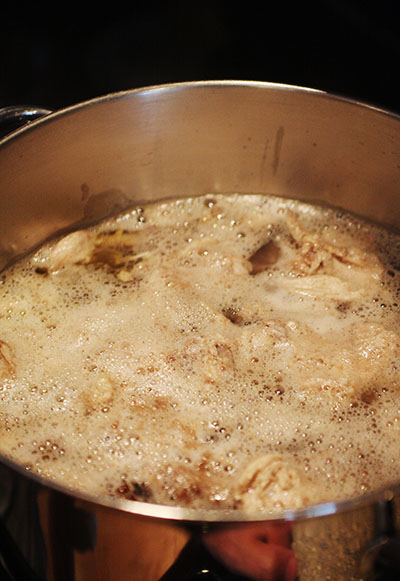
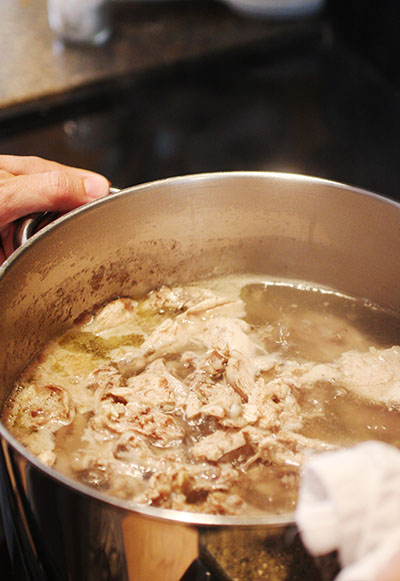




Once rinsed, the bones and meat go back into the clean stockpot, and I add 20 cups of water (5 quarts).

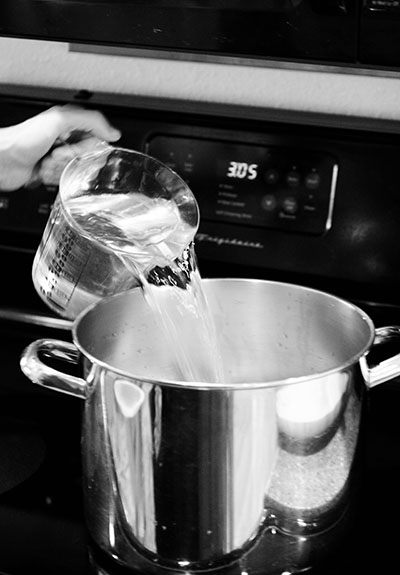
This is brought up slowly to a very gentle simmer. Like, a bubble every couple seconds after 45 minutes of heating. 180-190F degrees is ideal, and some cooks like Ruhlman just throw the whole pot in a 180 degree oven and check it every now and then. Personally, I like direct heat a little better than indirect oven heat, but whatever keeps the stock at that temperature is fine, the stock won't know the difference. If any scum or fat or foam floats to the surface, remove it with a spoon or ladle, but blanching should have taken care of a lot of this.
The only two hard and fast rules at this point are: 1) Don't let the stock boil. Boiling will create an emulsion of fine particles, making it hard to have a clear, tasty stock. It might also start to chemically break down some undesirable things in the bones and connective tissue and release that stuff into the stock with the same result. 2) Don't add any salt at all. Many sauces and recipes either reduce stock (sometimes to 1/10th or more of its original volume) or add already seasoned ingredients (like a braise). If 20 cups of stock are salted to a nice flavorful liquid, the salt will be overwhelming when later reduced, or mixed with other kinds of ingredients.
When it comes to adding mirepoix, there is a lot of leeway. Some prefer to add no vegetables at all, giving a pure chicken taste. Similar with a bouquet garni (fresh herbs and sometimes peppercorns) -- some feel the herbs may clash with whatever herbs may later be added to a sauce. Personally, I like a mirepoix, but I avoid the herbs. I figure the mirepoix basically creates a court-boullion stock that enhances the meat, but I do feel that herbs may clash if I want to make something delicate later.
The type of mirepoix is also debatable. Some feel too many carrots will make a stock sweet. Keller uses leeks instead of celery because he feels celery has a bitterness to it. Personally, I like to use shallots instead of onions, because I like the richer, less sulfur aroma. Some add the vegetables immediately, others (like myself) wait until the last hour.
This is all nitpicky stuff. Mirepoix or no, herbs or no, as long as it doesn't boil and there's no added salt, then it'll be light years better than anything out of a can, box, or jar.
After simmering alone for an hour and a half, I chop carrots, celery, and shallots into chunks. Peel the carrots and shallots and wash the celery -- if the vegetables are as clean as you'd normally cook with, the stock will be that much more refined.


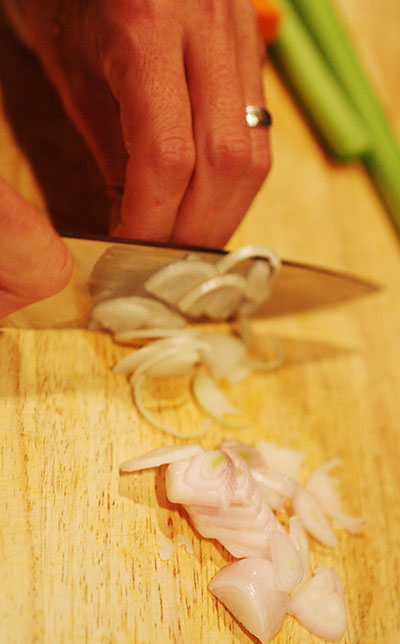

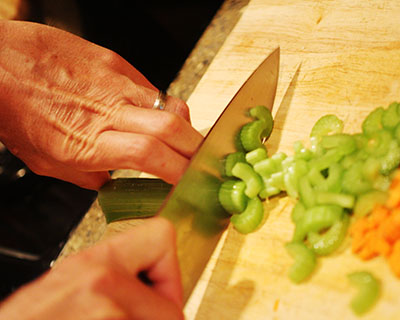
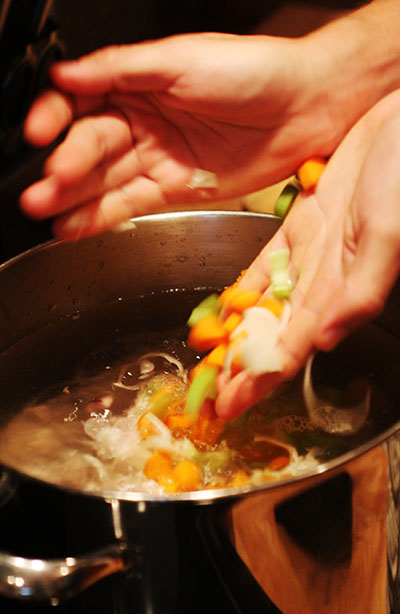
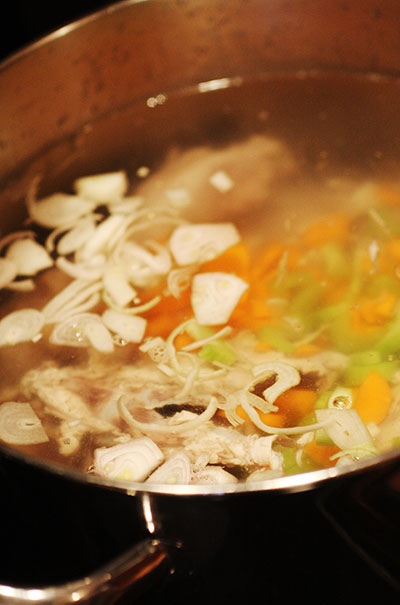
That last picture is a pretty nice shot of what the stock should look like after the vegetables are added. It's not crystal clear like a consommé, but it shouldn't be milky or too cloudy. The carrots and chicken visible in that picture are probably halfway down the pot, but they're still very visible, even given the blurring from the camera's narrow depth-of-field.
After another hour (about 2.5 hours total), the chicken stock is ready. You can taste it on a spoon and it should be watery tasting, with some chicken aroma (sprinkling a few grains of salt on your spoon with the spoonful of stock may give a cleaner taste-test, just don't salt the stock in the pot), but much thinner than soup or broth. It may feel a little thicker than water on the tongue.
Get a really large bowl. I use one of those cheap blue plastic salad bowls people bring fruit salad in to Fourth of July parties. Place a large stainless steel bowl in the big bowl and surround it with ice cubes. We're going to cool off the stock as quickly as we can for health reasons: warm stock is a wonderful breeding ground for bacteria, and lab scientists use warm stock specifically for growing cultures. Bathing the stainless steel bowl in an ice bath will cool it quickly. Very few home refrigerators have the power to cool 5 quarts of 180 degree stock -- they just can't keep up.
To strain, gently take the larger chunks and bones out of the stockpot, taking care not to agitate the stock too much and kick up any cloudy particles on the bottom. A ladle at a time, gently put the stock into a fine strainer with some cheesecloth. Let the stock flow through, don't press any solids through. This gets a little hypnotic after a while -- ladle, drip drip drip, ladle, drip drip drip.
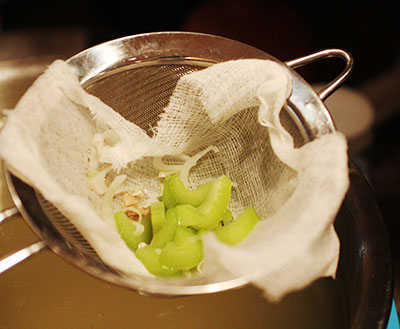


Leave the last cup or so of stock in the pot if it has any graininess or sediment in it. As the ice melts, use a baster to remove the water and add more ice. The stock should cool to room temperature in under an hour.
Once it's cool, I divide it up into the 1 cup or the 1/2 cup containers, mark it, and freeze it.
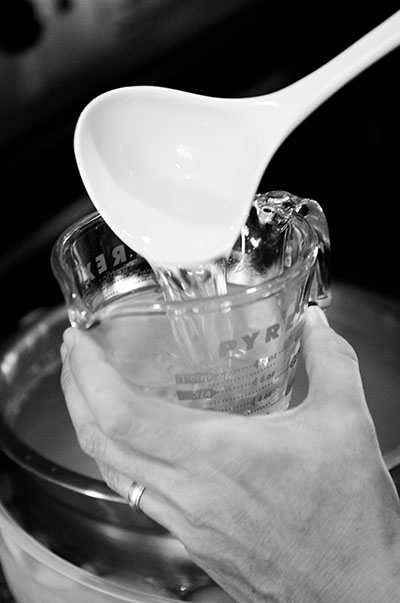
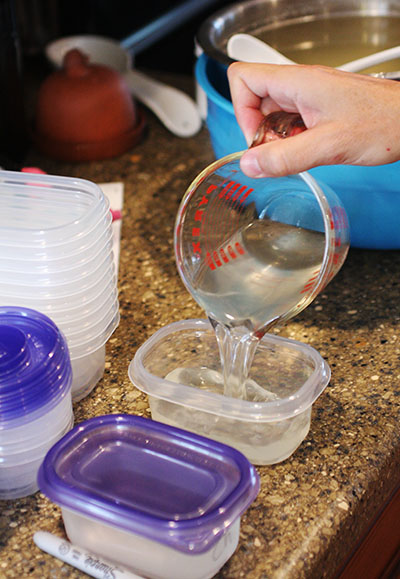

This seems like a lot of steps, but 95% of chicken stock making boils down (so to speak) to the two rules: Don't Boil. No Salt.
As compared to other stocks, chicken stock is a pretty easy stock to make, it doesn't take 10 hours like veal stock or three days like a demi glace. As far as flavoring, it's pretty neutral, much less chicken-tasting than soup or broth. It's not as neutral as veal stock, but it's certainly more universal than shrimp or lamb stock. I often use chicken stock in sauces for grouper, shrimp, duck, and lobster. It's a good thing to have on hand, and like Bourdain says, it makes the house smell nice for a day.



